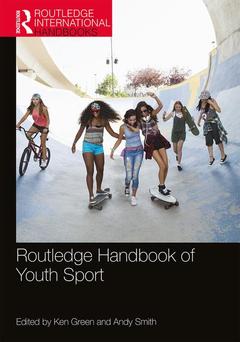Description
Routledge Handbook of Youth Sport
Routledge International Handbooks Series
Language: English
Subjects for Routledge Handbook of Youth Sport:
Keywords
youth sport; youth culture; talent identification; exercise and health; sports development; sport policy; leisure studies; physical education; ken green; Young Men; andy smith; Positive Youth Development; Anorexia Nervosa; DMSP; UK Sport; Elite Youth Sport; Lifestyle Sports; De Bosscher; Elite Sport Policy; Youth Sport Participation; Sports Participation; Young Athletes; Community Sports Coaches; Youth Life Stage; Elite Sport; Elite Youth Sport Policy; Eating Disorders; Youth Sport Programmes; Personal Development; Sedentary Behaviour; Van Bottenburg; Youth Sport Policy; LTAD Model; Extra Curricular
Publication date: 01-2018
· 17.4x24.6 cm · Paperback
Publication date: 01-2016
· 17.4x24.6 cm · Hardback
Description
/li>Contents
/li>Readership
/li>Biography
/li>
The RoutledgeHandbook of Youth Sport is a comprehensive survey of the latest research into young people?s involvement in sport. Drawing on a wide diversity of disciplines, including sociology, psychology, policy studies, coaching, physical education and physiology, the book examines the importance of sport during a key transitional period of our lives, from the later teenage years into the early twenties, and therefore helps us develop a better understanding of the social construction of young people?s lives.
The book covers youth sport in all its forms, from competitive game-contests and conventional sport to recreational activities, exercise and lifestyle sport, and at all levels, from elite competition to leisure time activities and school physical education. It explores youth sport across the world, in developing and developed countries, and touches on some of the most significant themes and issues in contemporary sport studies, including physical activity and health, lifelong participation, talent identification and development, and safeguarding and abuse.
No other book brings together in one place such a breadth and depth of material on youth sport or the engagement of young people in physical activity. The Routledge Handbook of Youth Sport is therefore important reading for all advanced students, researchers, practitioners and policy-makers with an interest in youth sport, youth culture, sport studies or physical education.
Introduction Section 1: Youth sport in context 1.1. Introduction 1.2. Young people and social change 1.3. Youth leisure as the context for youth sport 1.4. Youths’ use of time from comparative, historical and developmental perspectives 1.5. Youth, sport and leisure careers Section 2: Youth sport around the world 2.1. Introduction 2.2. Youth sport participation: a comparison between European member states 2.3. Youth sport in Norway 2.4. Youth sport in the United States 2.5. Youth sport in Australasia 2.6. Youth sport in Japan 2.7. Youth sport in the Middle East 2.8. Youth sport in China Section 3: Trends in youth sport 3.1. Introduction 3.2. Tracking and youth sport: the quest for lifelong adherence to sport and physical activity 3.3. Dropping out from clubs, dropping in to sport light? Organizational settings for youth sports participation 3.4. Indoorising the outdoors: Tempting young people’s interests in lifestyle sports 3.5. Lifestyle and adventure sports among youth Section 4: Socialisation and youth sport 4.1. Introduction 4.2. Parenting and youth sport 4.3. Peer group experiences in youth sport 4.4. Understanding take-up, drop-out and drop-off in youth sport 4.5. A personal assets approach to youth sport Section 5: Social divisions and youth sport 5.1. Introduction 5.2. Playing an unequal game? Youth sport and social class 5.3. Sexuality, gender and youth sport 5.4. Youth sport, 'race' and ethnicity5.5. Sport, youth and religion 5.6. Youth sport and dis/ability 5.7. Unpacking gender/sexuality/disability/social class to understand the embodied experiences of young people in contemporary physical culture 5.8. Youths’ participation rights in relation to dominant movement cultures Section 6: Youth sport, physical activity and health 6.1. Introduction 6.2. Physical activity and sedentary behaviour in youth 6.3. The health-enhancing effects of physical activity among youth 6.4. Measuring physical activity among youth6.5. Youth sport, health and physical activity 6.6. Youth sport and mental health 6.7. Eating disorders in young athletes 6.8. Everyday distortions: youth sport and body images 6.9. Youth sport, cigarettes, alcohol and illicit drugs Section 7: Elite youth sport 7.1. Introduction 7.2. The elements of talent development in youth sport7.3. Talent identification and development in youth sport 7.4. Health, well-being and the ‘logic’ of elite youth sports work 7.5. Child abuse in sport: from research to policy and prevention Section 8: Politics and policy in youth sport 8.1. Introduction 8.2. Elite youth sport policy and dual career support services in fifteen countries 8.3. Youth sport policy in small states 8.4. Youth and sport-for-change programmes: what can you expect? 8.5. Enacting youth sport policy: towards a micro-political and emotional understanding of community sports coaching work
Ken Green is Professor of Sociology of Physical Education and Youth Sport and Head of Sport and Exercise Sciences at the University of Chester, UK, as well as Visiting Professor at Hedmark University College, Norway, and the University of Wolverhampton, UK. He is Editor-in-Chief of the European Physical Education Review and his books include Understanding Physical Education (2008) and Key Themes in Youth Sport (2010). His main research interests revolve around physical education and youth sport.
Andy Smith is Professor of Sport and Physical Activity at Edge Hill University, UK, where he is also Associate Head of the Department of Sport and Physical Activity. His research interests and publications focus on sport, physical activity and health and on youth, sport policy and development. He is co-author of Sport Policy and Development (with Daniel Bloyce, 2010), An Introduction to Drugs in Sport (with Ivan Waddington, 2009) and Disability, Sport and Society (with Nigel Thomas, 2009), and co-editor of Doing Real World Research in Sports Studies (with Ivan Waddington, 2014). Andy is also a former co-editor of the International Journal of Sport Policy and Politics, which he launched with Barrie Houlihan and Daniel Bloyce in 2009, and an Editorial Board member of Leisure Studies and the European Physical Education Review.




